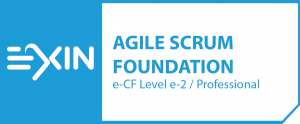EXIN-Agile Scrum
Foundation
Course Description
EXIN Agile Scrum Foundation is a certification that validates a professional’s blended knowledge in Agile methodologies and Scrum practices. Agile Scrum is about working together to successfully reach the goal. Agile methodologies are popular approaches in software development and are increasingly being used in other areas. Scrum practices include establishing cross-functional and self-managed teams, producing a working deliverable at the end of each iteration or Sprint.
Accredited By

Examination details
Who should take it?
The Agile way of thinking is best known in the field of software development but the principles are increasingly being applied in other types of projects. Scrum is the most used Agile methodology and the module is suitable for all professionals looking to keep their knowledge up to date with the latest developments in the fields of IT and Project Management, particularly those leading or participating in projects. In particular, the certification is suitable for professionals working in the areas of: Project Management; Software development; IT Service Management; and Business Management.
Syllabus – Agile Scrum Foundation
EXAM CONTENT
Candidates are being tested on the following subjects:
1. Introduction to Agile and Scrum
2. Scrum practices
3. Scrum planning
4. Monitoring Scrum projects
5. Advanced Scrum concepts